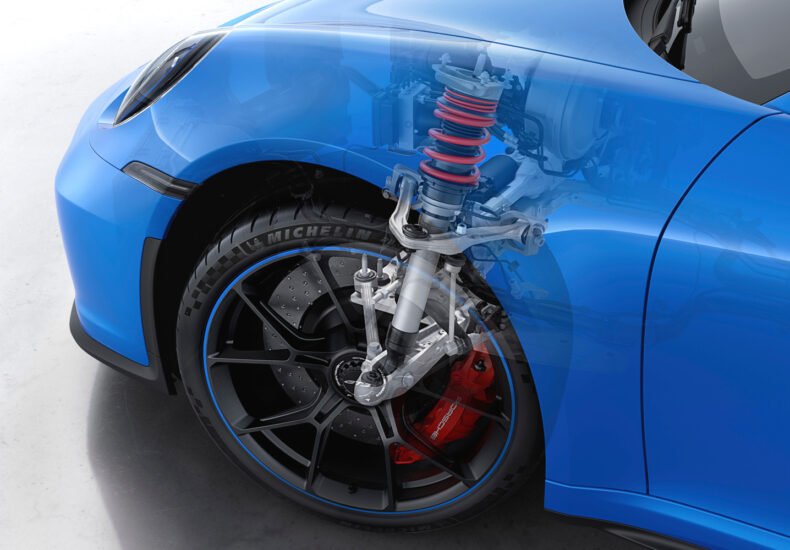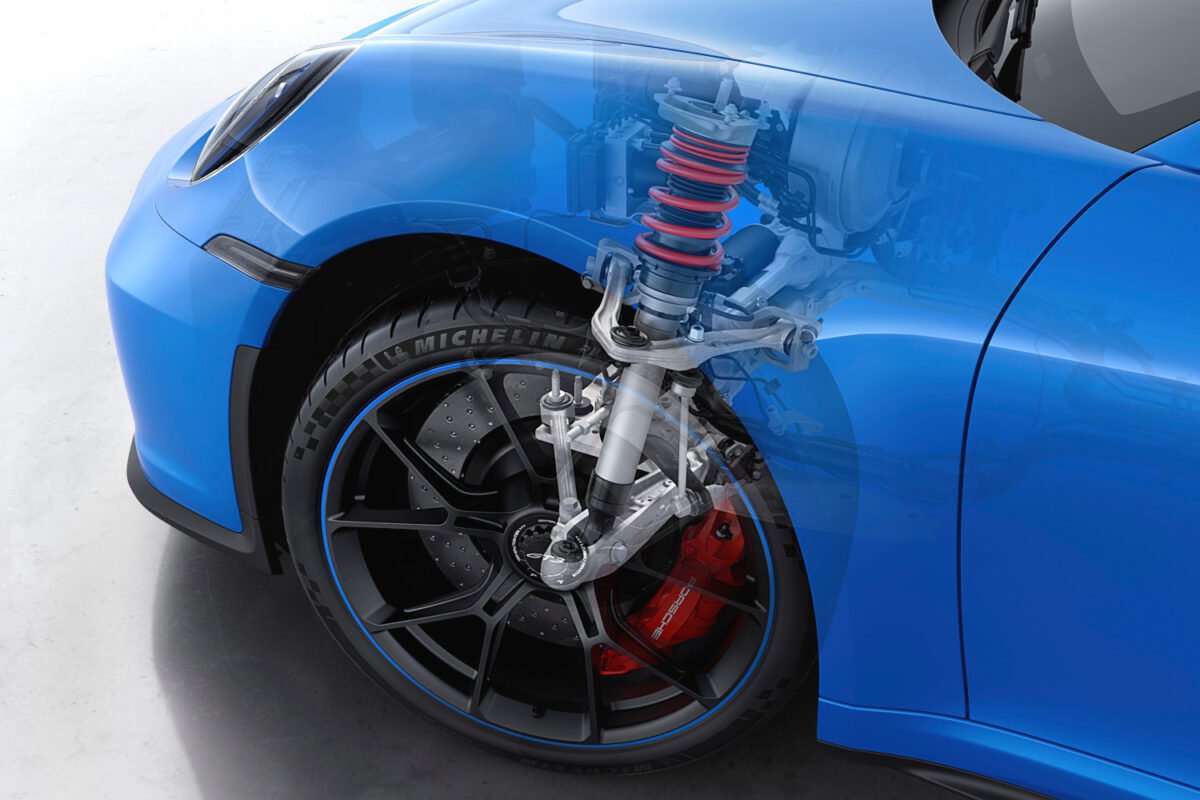
What is the Double Wishbone Suspension?
Porsche introduced the 992-generation Porsche 911 GT3 with the new double wishbone front suspension. But what is the double wishbone suspension, and how is it better? Let’s find out.
What is the Double Wishbone Suspension
The double wishbone system is an independent suspension system that features two control arms. The suspension on each wheel is independent, so the bumps in the road does not affect the other side. Many other suspension systems, like the more common MacPherson strut suspension, the double wishbone suspension features two control arms, upper and lower. Hence the name “double wishbone suspension”. Other name for this system is a double arm suspension system. But because the control arm looks a bit like the V-shaped bone of a Christmas turkey, which is called a wishbone, the control arm is known by the same name.
The double wishbone suspension was first used by the French car manufacturer Citroen and the American Packard in the 1930s. Since then, it has been featured in some high-performance models. It is also used in open-wheel racing cars, like Formula 1. Porsche first used the double wishbone front suspension setup on the RS Spyder LMP2 prototype racer in 2005. It was then adopted for the 911 RSR Le Mans class winner in 2017. The 992-generation Porsche 911 GT3 was the first Porsche 911 street car to feature this motorsport-derived technology
Advantages of the Double Wishbone Suspension
The double wishbone front axle offers numerous advantages compared with the conventional McPherson spring strut layout. It gives technicians flexibility to adjust parameters like camber, caster and toe to meet the requirements of the track or road. It offers higher camber stiffness under high compression and provides more constant support specifically for the wheel on the outside of a bend. This makes it possible to call on higher cornering force potential over the entire spring travel.
In addition, the double wishbone front axle eliminates the disturbance from lateral forces on the shock absorbers when cornering. These can lead to distortion in the form of bending loads and cause higher frictional losses. In short, the double wishbone suspension makes the sports car faster and more predictable, and improves driveability.
What about the Disadvantages?
So why don’t all cars have double wishbone front suspension? Well, there are a few drawbacks. First, it’s difficult to fit into front-wheel drive cars. Second, it’s heavier and takes up more space than a MacPherson strut suspension. And perhaps most importantly, it’s more complex. Which means it’s more expensive to manufacture and produce. And if something goes wrong, it takes much more work to fix. So unfortunately, it’s limited to the lucky few who get to enjoy it.

Image by Porsche
You may also like
Latest Additions
- Porsche 911 (991.2) Option Codes (MY2017)
 Here are the Porsche 911 (991.2) option codes with descriptions from model year 2017. Options list may vary depending on the year/country
Here are the Porsche 911 (991.2) option codes with descriptions from model year 2017. Options list may vary depending on the year/country - Race Car: Porsche 935 (2019)
 The limited-edition 2019 Porsche 935 clubsport racer pays tribute to the legendary Porsche 935/78 Le Mans race car
The limited-edition 2019 Porsche 935 clubsport racer pays tribute to the legendary Porsche 935/78 Le Mans race car - Michelin Pilot Sport S 5 – Great for Wet Conditions
 Track tyres are usually designed to provide optimal grip in dry conditions. For those drivers who don’t mind a little rain, the Michelin Pilot Sport S 5 is a perfect option for prolonging the track-day season. Michelin Pilot Sport S 5 Jointly developed by Porsche and Michelin, the Michelin Pilot Sport S 5 is a
Track tyres are usually designed to provide optimal grip in dry conditions. For those drivers who don’t mind a little rain, the Michelin Pilot Sport S 5 is a perfect option for prolonging the track-day season. Michelin Pilot Sport S 5 Jointly developed by Porsche and Michelin, the Michelin Pilot Sport S 5 is a - What is the 2023 Porsche 911 Sport Classic?
 The 2023 Porsche 911 Sport Classic is a limited-edition model with distinctive design cues inspired by iconic 911 models from history
The 2023 Porsche 911 Sport Classic is a limited-edition model with distinctive design cues inspired by iconic 911 models from history - Guards Red 2025 Porsche 911 GT3
 Red is a sports car color. But is red a GT3 color? You might say "yes" after checking these images of a Guards Red 2025 Porsche 911 GT3
Red is a sports car color. But is red a GT3 color? You might say "yes" after checking these images of a Guards Red 2025 Porsche 911 GT3 - 2021 Porsche 911 GT3 Cup (992.1) Specs
 Here are the technical specifications of the 2021 Porsche 911 GT3 Cup (992.1) racing car based on the 992.1 generation of the Porsche 911
Here are the technical specifications of the 2021 Porsche 911 GT3 Cup (992.1) racing car based on the 992.1 generation of the Porsche 911 - Race Car: Porsche 911 GT3 RSR (2011)
 For the 2011 season, Porsche unveiled a new version of the Porsche 911 GT3 RSR with extensive modifications
For the 2011 season, Porsche unveiled a new version of the Porsche 911 GT3 RSR with extensive modifications - 2025 Porsche 911 Carrera Cabriolet PDK (992.2) Specs
 Here are the technical specifications of the 2025 Porsche 911 Carrera Cabriolet (992.2) with the PDK transmission
Here are the technical specifications of the 2025 Porsche 911 Carrera Cabriolet (992.2) with the PDK transmission - 2025 Porsche 911 Carrera Cabriolet – 10 Fast Facts
 The 992.2 generation Porsche 911 Carrera Cabriolet was introduced for the 2025 model year. Here are 10 fast facts about the 2025 Porsche 911 Carrera Cabriolet
The 992.2 generation Porsche 911 Carrera Cabriolet was introduced for the 2025 model year. Here are 10 fast facts about the 2025 Porsche 911 Carrera Cabriolet - Porsche Design Chronograph 911 Turbo S (2025)
 Inspired by the new 2026 Porsche 911 Turbo S, Porsche Design has released a new Chronograph 911 Turbo S watch
Inspired by the new 2026 Porsche 911 Turbo S, Porsche Design has released a new Chronograph 911 Turbo S watch
